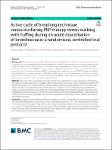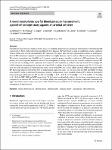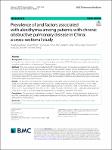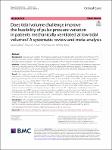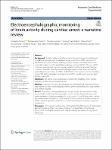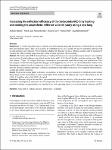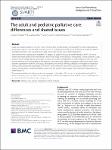Search
Author
- Osman, Ahmed I. (5)
- Daqing, Ma (3)
- Jorgensen, Ed (3)
- Li, Yan (3)
- next >
Subject
- kinh tế (26)
- Economics (12)
- programming (10)
- XRD (10)
- next >
Date issued
- 2020 - 2025 (2129)
- 2010 - 2019 (129)
- 2000 - 2009 (9)
- 1999 - 1999 (1)
Has File(s)
Search Results
Sample correlations and feature relations are two pieces of information that are needed to be considered in the unsupervised feature selection, as labels are missing to guide model construction. Thus, we design a novel unsupervised feature selection scheme, in this paper, via considering the completed sample correlations and feature dependencies in a unified framework. Specifically, self-representation dependencies and graph construction are conducted to preserve and select the important neighbors for each sample in a comprehensive way. |
Airway clearance techniques (ACTs) for individuals with bronchiectasis are routinely prescribed in clinical practice and recommended by international guidelines, especially during an acute exacerbation. However, there is limited evidence of the efficacy of these techniques during an exacerbation to improve sputum expectoration, health-related quality-of-life (HRQOL) or exercise tolerance. The primary aim of this study is to compare the effects of the active cycle of breathing technique (ACBT), oscillating positive expiratory pressure (O-PEP) therapy, and walking with huffing on sputum expectoration for adults hospitalised with an acute exacerbation of bronchiectasis. |
Smartphones may provide a highly available access to simplified hypertension screening in environments with limited health care resources. Most studies involving smartphone blood pressure (BP) apps have focused on validation in static conditions without taking into account intraindividual BP variations. We report here the first experimental evidence of smartphone-derived BP estimation compared to an arterial catheter in a highly dynamic context such as induction of general anesthesia. We tested a smartphone app (OptiBP) on 121 patients requiring general anesthesia and invasive BP monitoring. |
Alexithymia is a common psychological disorder. However, few studies have investigated its prevalence and predictors in patients with chronic obstructive pulmonary disease (COPD). Therefore, we aimed to determine the prevalence and predictors of alexithymia in Chinese patients. |
Pulse pressure variation (PPV) has been widely used in hemodynamic assessment. Nevertheless, PPV is limited in low tidal volume ventilation. We conducted this systematic review and meta-analysis to evaluate whether the tidal volume challenge (TVC) could improve the feasibility of PPV in patients ventilated at low tidal volumes. |
To date cardiac arrest (CA) remains a frequent cause of morbidity and mortality: despite advances in cardiopulmonary resuscitation (CPR), survival is still burdened by hypoxic–ischemic brain injury (HIBI), and poor neurological outcome, eventually leading to withdrawal of life sustaining treatment (WLST). The aim of CPR is cardiac pump support to preserve organ perfusion, until normal cardiac function is restored. However, clinical parameters of target organ end-perfusion during CPR, particularly brain perfusion, are still to be identified. In this context, electroencephalography (EEG) and its derivatives, such as processed EEG, could be used to assess brain function during CA. |
Osteoporosis-related proximal femur fractures continue to increase significantly due to demographic change. This study was designed to evaluate the biomechanical stability of two different fixation methods (cerclage vs. screw) for refixation of a trochanter minor fragment in the pertrochanteric fractures in cadaveric bones. |
As volatile anaesthetic gases contribute to global warming, improving the efficiency of their delivery can reduce their environmental impact. This can be achieved by rebreathing from a circle system, but also by anaesthetic reflection with an open intensive care ventilator. We investigated whether the efficiency of such a reflection system could be increased by warming the reflector during inspiration and cooling it during expiration (thermocycling). |
COVID - 19 affected severely worldwide. The pandemic has caused many causalities in a very short span. The IoT-cloud-based healthcare model requirement is utmost in this situation to provide a better decision in the covid-19 pandemic. In this paper, an attempt has been made to perform predictive analytics regarding the disease using a machine learning classifier. This research proposed an enhanced KNN (k NearestNeighbor) algorithm eKNN, which did not randomly choose the value of k. However, it used a mathematical function of the dataset’s sample size while determining the k value. The enhanced KNN algorithm eKNN has experimented on 7 benchmark COVID-19 datasets of different size, which has been gathered from standard data cloud of different countries (Brazil, Mexico, etc.). |
Adult and pediatric palliative care (PC) share common aims and ethical principles but differ in many organizational and practical aspects. The aim of this narrative review is to analyze these differences and focus on which key aspects of pediatric palliative care could integrate adult services for a better care of suffering patients. |


